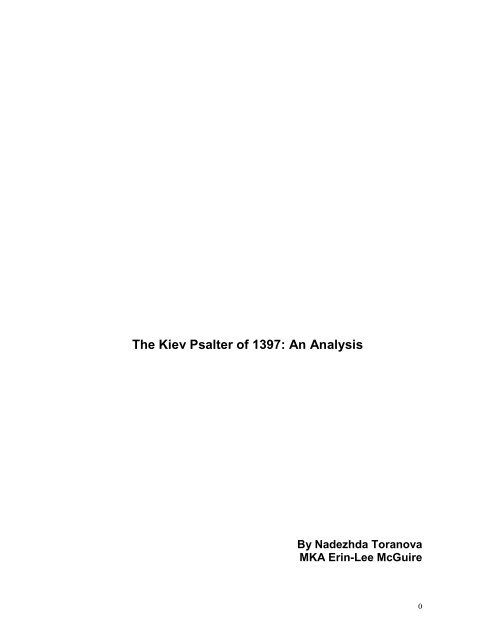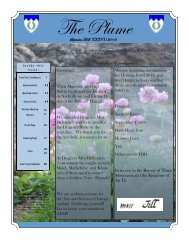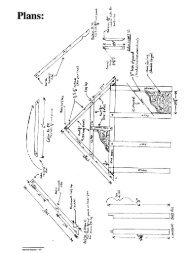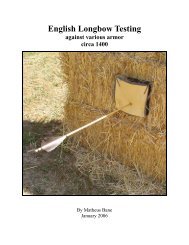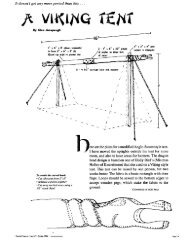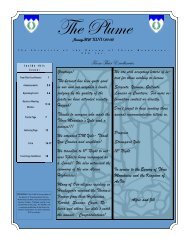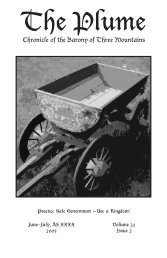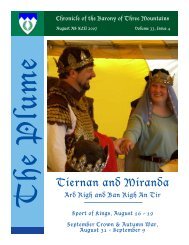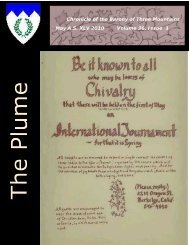The Kiev Psalter of 1397: An Analysis - CurrentMiddleAges.org
The Kiev Psalter of 1397: An Analysis - CurrentMiddleAges.org
The Kiev Psalter of 1397: An Analysis - CurrentMiddleAges.org
Create successful ePaper yourself
Turn your PDF publications into a flip-book with our unique Google optimized e-Paper software.
<strong>The</strong> <strong>Kiev</strong> <strong>Psalter</strong> <strong>of</strong> <strong>1397</strong>: <strong>An</strong> <strong>An</strong>alysis<br />
By Nadezhda Toranova<br />
MKA Erin-Lee McGuire<br />
0
<strong>The</strong> <strong>Kiev</strong> <strong>Psalter</strong> 1 , also called the Spyridon <strong>Psalter</strong> is unique. It is the only<br />
preserved Slavonic manuscript <strong>of</strong> its kind dating to the period before the fifteenth<br />
century. It is also anachronistic, produced in <strong>1397</strong> but illustrated in a style typical <strong>of</strong> the<br />
eleventh century. A marginal <strong>Psalter</strong> 2 , it must have been a very valuable treasure in the<br />
medieval period as “the book <strong>of</strong> Psalms is <strong>of</strong> all books, the mother.” 3 <strong>The</strong> <strong>Kiev</strong> <strong>Psalter</strong><br />
has a straightforward past, with no real mysteries, and yet the manuscript itself is a<br />
mystery. Why were its illustrations copied from an earlier manuscript? Which<br />
manuscript served as the model? Why was it produced in <strong>Kiev</strong>, when all indications<br />
suggest that the scribe, artist and patron came from Moscow? <strong>An</strong>swers to these questions<br />
have been proposed, but they are theories only. Short <strong>of</strong> time travel, the answers will<br />
likely remain theories.<br />
<strong>The</strong> <strong>Kiev</strong> <strong>Psalter</strong> is a luxury volume, containing over 300 colourful miniatures<br />
throughout its 229 leaves. A large book (30 cm by 24.5 cm), it has wide margins: 3 cm<br />
on the top; 6 cm on the sides; and 7 cm on the bottom. <strong>The</strong>se margins are maintained<br />
throughout the manuscript and are generally filled with images and the occasional added<br />
commentary or text. <strong>The</strong> composition <strong>of</strong> the images varies from single figures to<br />
complex narratives filling the margins entirely. <strong>The</strong>re is one instance where a page was<br />
reserved for an image only: the frontispiece, portraying David composing the Psalms.<br />
<strong>An</strong>other full-page image was added later, to the other side <strong>of</strong> the same folio. <strong>The</strong> rest <strong>of</strong><br />
the images serve in conjunction with the text and are meant to be read at the same time.<br />
<strong>The</strong> text <strong>of</strong> the manuscript consists <strong>of</strong> the psalms (folios 2-205), the Odes (205-227) and a<br />
few brief liturgical texts and prayers that were added later (228-9). 4 All <strong>of</strong> the text<br />
written in <strong>1397</strong> was written in a liturgical uncial script with large, illuminated initials<br />
used frequently. <strong>The</strong> original binding was replaced in the nineteenth century with green<br />
velvet panels. Unfortunately, the person who rebound the manuscript appears to have<br />
cropped the pages, as the damaged commentary on folio 197 recto would seem to<br />
indicate. In addition, folios 145 and 154-6 were replaced in the seventeenth century with<br />
1<br />
Saltykov-Shchedrin Public Library, Leningrad, MS F 6, <strong>Kiev</strong>, <strong>1397</strong><br />
2<br />
A marginal <strong>Psalter</strong> contains its images in the margins, as opposed to frontispieces and miniatures.<br />
3<br />
Russian Proverb, quoted in G. Vzdornov. Commentary on the <strong>Kiev</strong>an <strong>Psalter</strong> (Moscow: Iskustvo, 1978),<br />
150.<br />
4<br />
Vzdornov. Commentary, 147.<br />
1
paper pages containing no images. As <strong>of</strong> 1978, the manuscript was being kept unbound<br />
in the Leningrad Public Library. 5<br />
Two details contained within the manuscript itself allow modern scholars to trace<br />
some <strong>of</strong> the early history <strong>of</strong> the <strong>Kiev</strong> <strong>Psalter</strong>. It contains a colophon on folio 227 recto,<br />
identifying Bishop Mikhail as the patron and Archdeacon Spyridon as the scribe. It<br />
further states that the manuscript was produced in the city <strong>of</strong> <strong>Kiev</strong> in the year 6905, (<strong>1397</strong><br />
by the Gregorian Calendar). <strong>The</strong> next significant entry into the manuscript appears in the<br />
bottom margins <strong>of</strong> folios 1 verso through 13 verso. This set <strong>of</strong> 40 lines is occasionally<br />
wrapped around the images in the bottom margins, skipping on those pages where the<br />
margins are already full. Added in the sixteenth century, the inscription identifies<br />
Abraham Joseph Hlebicky, the State Treasurer <strong>of</strong> the Grand Principality <strong>of</strong> Lithuania as<br />
the manuscript’s owner. 6 He had his coat-<strong>of</strong>-arms added to the very first folio and the<br />
inscription was added to mark his donation <strong>of</strong> the manuscript to the Church <strong>of</strong> St<br />
Nicholas in the town <strong>of</strong> Vilno. 7 <strong>The</strong> date given is 1518. 8 Unfortunately, there does not<br />
appear to be any way to trace the <strong>Psalter</strong>’s path from <strong>Kiev</strong> and Moscow to Lithuania in<br />
the period between <strong>1397</strong> and 1518. According to Vzdornov, there are several<br />
inscriptions in the <strong>Kiev</strong> <strong>Psalter</strong> which were written in Polish and Latin. He suggests that<br />
these indicate a long-term presence in Lithuania. Unfortunately, other than the<br />
inscription just mentioned, these are not readily apparent in the manuscript, making it<br />
difficult to agree or disagree with the commentator.<br />
It is interesting to note that there are no other <strong>Kiev</strong>an manuscripts <strong>of</strong> this same<br />
period. However, there are at least three Gospels in Moscow that Spyridon is believed to<br />
have either contributed to or produced: a 1393 Gospel, 9 the Khitrovo Gospel, 10 and the<br />
Gospel from the Cathedral <strong>of</strong> the Assumption. 11 Scholars generally agree that Spyridon<br />
was probably the archdeacon <strong>of</strong> the Cathedral <strong>of</strong> the Assumption in the Moscow Kremlin,<br />
and that he worked for the Metropolitan Cyprian <strong>of</strong> Moscow (1390-1407) as well as<br />
Grand Duke Vasily I (1389-1425). 12 Similarly, scholars also agree that the language used<br />
5 Ibid.<br />
6 Ibid.<br />
7 modernly Vilnius<br />
8 Vzdornov. Commentary, 147.<br />
9 Leningrad Public Library, FPI 18<br />
10 Lenin Library, Moscow, file 304, III, no. 4/m. 8654<br />
11 Moscow Krelim Armoury, no. 11056.<br />
12 Vzdornov. Commentary, 149.<br />
2
in the <strong>Kiev</strong> <strong>Psalter</strong> suggests the Moscow origin <strong>of</strong> its scribe. 13 Records indicate that<br />
Metropolitan Cyprian and Bishop Mikhail spent one and a half years together in <strong>Kiev</strong> in<br />
1396-7. Spyridon must have been with them while working on Bishop Mikhail’s <strong>Psalter</strong>.<br />
<strong>The</strong> bishop was a monk in the Moscow Monastery in the 1370’s, but became the Bishop<br />
<strong>of</strong> Smolensk in 1383. Shortly after becoming bishop, it appears that he was sent on<br />
several diplomatic missions to Moscow, Constantinople and finally <strong>Kiev</strong>. <strong>The</strong> records at<br />
the Monastery <strong>of</strong> the Trinity near Moscow indicate that he died at the monastery and was<br />
buried there. 14 According to Vzdornov, Russian colophons do not typically indicate the<br />
place <strong>of</strong> composition unless there is something unusual, for example, if the scribe is away<br />
from home during production. 15 This would seem to be consistent with the church<br />
documents analyzed by Vzdornov and others in regards to the making <strong>of</strong> the <strong>Kiev</strong> <strong>Psalter</strong>.<br />
As mentioned above, the <strong>Psalter</strong>’s history is unknown from the date indicated by<br />
the colophon until the second date, 1518, when Abraham Hlebicky donated it to the<br />
Church <strong>of</strong> St Nicholas. It appears that the <strong>Kiev</strong> <strong>Psalter</strong> remained in the church’s library<br />
for some time. It was re-discovered in the 1820’s by a pr<strong>of</strong>essor from the University <strong>of</strong><br />
Vilno, and a “prominent figure in the Greco-Uniate Church <strong>of</strong> Lithuania”, who made its<br />
discovery public. 16 Several collectors attempted to acquire the manuscript, but it was not<br />
put up for sale until a new dean arrived at the church in 1828. Dean M.K. Bobrowski<br />
sold the <strong>Psalter</strong> to a bibliophile named W. Trebicky in 1847. In 1861, Trebicky willed it<br />
to Count A.S. Zamoyski <strong>of</strong> Warsaw. However, the manuscript did not remain in Warsaw<br />
long, somewhere between 1874 and 1881 it appeared in the possession <strong>of</strong> Prince P.P.<br />
Vyazemsky <strong>of</strong> Petersburg who finally sold it to Count S.D Sheremetev, one <strong>of</strong> the<br />
founders <strong>of</strong> the Society <strong>of</strong> Amateurs <strong>of</strong> <strong>An</strong>cient Texts and Art. <strong>The</strong> count housed the<br />
society’s museum in his palace in Petersburg and in 1881 the <strong>Kiev</strong> <strong>Psalter</strong> joined that<br />
collection. When the entire collection passed to the Leningrad Public Library in 1932,<br />
the manuscript was unbound into gatherings, which were then cleaned and flattened. 17<br />
Within decades <strong>of</strong> being discovered, the manuscript was already the subject <strong>of</strong><br />
considerable analysis. Most <strong>of</strong> the published works were done in the late nineteenth<br />
century in Polish, Lithuanian and Russian and unfortunately are not available in<br />
13 ibid., 148.<br />
14 ibid., 149.<br />
15 ibid.<br />
16 ibid., 148.<br />
17 ibid.<br />
3
translation. By 1890 the Society <strong>of</strong> Amateurs <strong>of</strong> <strong>An</strong>cient Texts and Art had planned to<br />
publish a lithographic facsimile, but for some reason they failed to complete the project.<br />
<strong>An</strong>other attempt was made in 1900, and again during the early years <strong>of</strong> the Soviet regime,<br />
but it was not until 1978 that a complete facsimile was made. 18<br />
While the text was undoubtedly written by Spyridon, the manuscript’s<br />
illustrations are believed to be the product <strong>of</strong> an artist from a Moscow scriptorium.<br />
According to Olga Popova, the style <strong>of</strong> illustration is clearly the work <strong>of</strong> an artist trained<br />
in the Moscow School. 19 Both Popova and Vzdornov agree that the illuminator had a<br />
keen understanding <strong>of</strong> Byzantine book art in the eleventh century. <strong>The</strong> miniatures are<br />
copied skillfully, containing light, dynamic figures, vivid colour combinations and<br />
contrasts without shading. <strong>The</strong> figures are given a ethereal feel through the use <strong>of</strong> gold<br />
lines for highlighting. In contrast to typical Byzantine icons <strong>of</strong> the period, the figures are<br />
also very expressive, faces clearly showing emotions like joy and sorrow. <strong>The</strong>ir gestures<br />
are dynamic and the scenes have a sense <strong>of</strong> movement not typical <strong>of</strong> eleventh-century<br />
manuscript art. 20 Of particular interest is the illustrator’s use <strong>of</strong> planes within a scene.<br />
Multiple planes are indicated through the use <strong>of</strong> architecture, landscape, and objects. For<br />
example, on folio 197 recto, the main figure in the scene appears twice: on the ground<br />
and in the tree. This presents a sense <strong>of</strong> both space and the passage <strong>of</strong> time.<br />
Although the style is a blend <strong>of</strong> Byzantine and Russian schools, the iconography<br />
is clearly Byzantine. <strong>The</strong> miniatures include scenes <strong>of</strong> the Nativity with the typically<br />
Eastern bathing scene, multiple images <strong>of</strong> the <strong>An</strong>astasis, dozens <strong>of</strong> personifications <strong>of</strong><br />
rivers and other natural phenomena, and a brilliant Last Judgement scene that completely<br />
fills the margins <strong>of</strong> folio 180 recto. <strong>The</strong>se Byzantine iconographic trends are examined in<br />
more detail below. In addition to the Byzantine iconography, folio 2 recto begins with a<br />
headpiece containing a septet deësis. Christ is flanked by Mary, John the Baptist, the<br />
archangels Michael and Gabriel and the Apostles Peter and Paul. <strong>The</strong> entire set is<br />
contained within an ornate frame composed <strong>of</strong> a floral motif executed in gold and vivid<br />
colour. <strong>The</strong> headpiece occupies one third <strong>of</strong> the space normally reserved for text. <strong>The</strong><br />
Moscow Museum <strong>of</strong> Art and Industry completed a survey <strong>of</strong> Medieval Russian and<br />
Byzantine manuscript ornament, which made apparent certain trends in purely decorative<br />
18 ibid.<br />
19 Olga Popova, Russian Illuminated Manuscripts . Trans. by K. Cook, V. Ivanov, L. Sorokina. (London:<br />
Thames and Hudson, ltd., 1984), plate 28 and commentary.<br />
4
ornament. <strong>The</strong> style <strong>of</strong> the deësis frame is very like some <strong>of</strong> the ones used in Byzantine<br />
manuscript art <strong>of</strong> the tenth and eleventh centuries. 21 Conversely, the fourteenth-century<br />
headpieces are typically in the knot-work style <strong>of</strong> the <strong>Psalter</strong> <strong>of</strong> Ivan the Terrible. 22 This<br />
seems to further support the evidence suggesting an eleventh-century model for the <strong>Kiev</strong><br />
<strong>Psalter</strong>.<br />
<strong>The</strong> manuscript illustrations are <strong>of</strong> various types, including a frontispiece,<br />
commentary, narrative illustration and decorated initials. <strong>The</strong> frontispiece portrays David,<br />
sitting within an architectural frame, and writing the psalms. This style is very<br />
conventional, occurring in numerous psalters and other kinds <strong>of</strong> religious manuscripts <strong>of</strong><br />
the Russian medieval period. <strong>The</strong> rest <strong>of</strong> the illustrations appear to belong to two<br />
thematic groups: commentary and narrative. <strong>The</strong> nature <strong>of</strong> these illustrations is directly<br />
connected to the purpose <strong>of</strong> the manuscript, as illustrated by J. <strong>An</strong>derson’s analysis <strong>of</strong> the<br />
<strong>The</strong>odore <strong>Psalter</strong>. 23 He states that<br />
One can demonstrate how the <strong>Psalter</strong> evolved from a study<br />
text rooted in and reinforcing a view <strong>of</strong> man’s place in a<br />
structured plan to a book <strong>of</strong> moral lessons pertaining to the<br />
conduct <strong>of</strong> life and illuminating the individual’s<br />
relationship to God. 24<br />
<strong>The</strong> <strong>Kiev</strong> <strong>Psalter</strong>, like the <strong>The</strong>odore <strong>Psalter</strong>, was produced for use by specific members <strong>of</strong><br />
the clergy, who would be able to comprehend the layered meanings within the text and<br />
images.<br />
<strong>An</strong>derson identifies a group <strong>of</strong> ten manuscripts produced over a five hundred-year<br />
period based on studies done by J. Tikkanen. 25 He goes on to discuss the various<br />
analyses <strong>of</strong> the manuscripts which group them into clusters based on period. Ultimately,<br />
he appears to conclude that the marginal psalters <strong>of</strong> the eleventh century are generally<br />
interpretive, personalized copies <strong>of</strong> their ninth-century counterparts. 26 At the same time,<br />
20 Popovo, Russian Illuminated Manuscripts, 19. Vzdornov, Commentary, 152.<br />
21 Moscow Museum Of Art <strong>An</strong>d Industry, Medieval Russian Ornament In Full Color: From Illuminated<br />
Manuscripts, (New York: Dover Publications, 1994), 3.<br />
22 Lenin Library, Moscow, ms M. 8662<br />
23 Jeffrey <strong>An</strong>derson, “On the Nature <strong>of</strong> the <strong>The</strong>odore <strong>Psalter</strong>,” Art Bulletin 70 (December 1988): 550-568.<br />
24 ibid., 550.<br />
25 ibid., 550.<br />
26 ibid., 551-3.<br />
5
he seems to indicate that the ninth-century Khludov <strong>Psalter</strong> at least partially served as a<br />
model for a group <strong>of</strong> manuscripts produced in the Studios Monastery during the eleventh<br />
century. 27 However, he is very adamant regarding the distinct nature <strong>of</strong> each manuscript,<br />
insisting that the illuminators were not limited to merely copying their model, but that<br />
they were free to interpret and expand upon it. He states:<br />
Accuracy to a single collection <strong>of</strong> images did not guide any<br />
<strong>of</strong> the illuminators, with the possible exception <strong>of</strong> the<br />
Barberini Painter. Virtually all <strong>of</strong> them consciously added<br />
and modified, presumably with some purpose in mind. 28<br />
As this was the trend in Byzantium, it is not unthinkable that the same trend existed in the<br />
schools <strong>of</strong> medieval Russia. <strong>The</strong>re are in fact, a number <strong>of</strong> similarities between the<br />
<strong>The</strong>odore, Khludov and <strong>Kiev</strong> <strong>Psalter</strong>s. Of course, there are a number <strong>of</strong> differences as<br />
well.<br />
All <strong>of</strong> these manuscripts contain numerous portraits <strong>of</strong> saints, typically identified<br />
with an inscription. <strong>The</strong> saints and King David are frequently portrayed standing with<br />
their arms raised in prayer. <strong>An</strong>derson suggests that this is an indication <strong>of</strong> the <strong>Psalter</strong>’s<br />
role as an instrument <strong>of</strong> mediation between the reader and God. 29 Contrastingly, it can be<br />
said that the prayer-like positioning <strong>of</strong> the figures emphasizes the role <strong>of</strong> the speaker. For<br />
example, in the <strong>Kiev</strong> <strong>Psalter</strong>, David typically appears either praying or speaking directly<br />
to Christ. <strong>The</strong> figure is usually linked to a line <strong>of</strong> the psalms, as though he is being<br />
portrayed in the act <strong>of</strong> reciting the words indicated.<br />
Other similarities include specific, non-iconographic sets <strong>of</strong> images. For<br />
example, the Khludov <strong>Psalter</strong> shows an image <strong>of</strong> “a bird nesting on a column as an<br />
illustration <strong>of</strong> Ps. 104:17” 30 (“Where the birds make their nests: as for the stork, the fir<br />
trees are her house.”) Fascinatingly, <strong>The</strong>odore chose to use exactly the same image, but<br />
assigned it to Ps. 102:7, (“I watch, and am as a sparrow alone upon the house top.”). <strong>The</strong><br />
<strong>Kiev</strong> <strong>Psalter</strong>, on the other hand, has three very similar images assigned to psalms 102-4.<br />
Psalm 102:6 is illustrated on folio 139 verso by an image <strong>of</strong> a stork in a tree, with David<br />
27 ibid., 553.<br />
28 ibid., 553.<br />
29 ibid., 566.<br />
30 ibid., 559. Please note: the psalms discussed here have all been converted to the numbering contained<br />
within the King James Version <strong>of</strong> the Bible for the sake <strong>of</strong> consistency.<br />
6
standing at its base, arms upraised in prayer. Image two is <strong>of</strong> an eagle in a tree on folio<br />
141 verso. At the base <strong>of</strong> a tree stands an old saint labeled старець, which can be<br />
translated as “old man”. <strong>The</strong> man is in exactly the same position and pose as David at the<br />
base <strong>of</strong> the tree on folio 139. <strong>The</strong> psalm to which the eagle is connected is 103:5 (“Who<br />
satisfieth thy mouth with good things; so that thy youth is renewed like the eagle’s”).<br />
<strong>The</strong> third image <strong>of</strong> the birds belongs to the very next psalm, 104:16-18, the same as the<br />
one seen in the Khludov <strong>Psalter</strong>. Again, the nest is in a tree, but this time it is occupied<br />
by more than one bird. At the base <strong>of</strong> the tree is an unidentifiable animal, possibly a<br />
goat, (“<strong>The</strong> trees <strong>of</strong> the Lord…/Where the birds make their nests…/<strong>The</strong> hills are a refuge<br />
for the wild goats…”). While it becomes tempting to posit the existence <strong>of</strong> either a<br />
manuscript or a specific scheme from which the Khludov, <strong>The</strong>odore and <strong>Kiev</strong> <strong>Psalter</strong>s<br />
must have derived, there is not enough evidence for this.<br />
<strong>An</strong>other similarity between the images <strong>of</strong> the Khludov and <strong>Kiev</strong> <strong>Psalter</strong>s occurs<br />
on folios 96 recto and 134 recto respectively, in connection to Ps 96. Both manuscripts<br />
contain elaborate illustrations <strong>of</strong> the construction <strong>of</strong> a house or sanctuary, including<br />
images <strong>of</strong> pulleys and people climbing on all levels <strong>of</strong> the building. However, the<br />
<strong>The</strong>odore <strong>Psalter</strong>, according to <strong>An</strong>derson, has a simple house in the same position with a<br />
modified version <strong>of</strong> the construction scene appearing next to Ps. 127. Again, this could<br />
suggest that the model for the <strong>Kiev</strong> <strong>Psalter</strong> either derived from the Khludov <strong>Psalter</strong> or<br />
from another manuscript similar to and possibly pre-dating it.<br />
<strong>The</strong>re are certain differences that are striking, and may serve to describe the<br />
attitudes <strong>of</strong> the Russian manuscript artist who copied the images. Two trends from the<br />
Khludov <strong>Psalter</strong> and the eleventh-century manuscripts that imitated it are seemingly<br />
absent from the <strong>Kiev</strong> <strong>Psalter</strong>. <strong>The</strong>re does not appear to be a single image <strong>of</strong> alms-giving<br />
in Spyridon’s work, whereas it appears repeatedly in the schemes <strong>of</strong> the Byzantine books.<br />
When discussing the trend in Byzantine manuscripts, <strong>An</strong>derson states that “charity is the<br />
medieval Byzantine virtue par excellence, 31 and while it should also be important in<br />
Russian culture <strong>of</strong> the medieval period, it does not appear to play a role in the <strong>Kiev</strong><br />
<strong>Psalter</strong>. Perhaps a more comprehensible divergence is the lack <strong>of</strong> reference to the<br />
iconoclasm in the Russian work. <strong>The</strong> period <strong>of</strong> iconoclasm occurred more than a century<br />
before the conversion <strong>of</strong> Russia to Christianity, and would therefore be a non-issue to<br />
31 Ibid., 560.<br />
7
Russian religious figures. <strong>The</strong> place <strong>of</strong> the icon was always secure in Russia. <strong>An</strong>derson<br />
suggests a link between the anti-iconoclast images <strong>of</strong> the Khludov <strong>Psalter</strong> with its<br />
illustrations <strong>of</strong> charity, 32 and this may explain why the subject <strong>of</strong> charity was neglected in<br />
the Russian manuscript. However, he also submits that the artists <strong>of</strong> the Studios<br />
Monastery had separated the schemes in their own work. 33 This could be an argument<br />
against the <strong>Kiev</strong> <strong>Psalter</strong>’s model having originated at Studios, but that is purely<br />
speculation and unfortunately, there is no way to explore it further.<br />
<strong>The</strong> most common type <strong>of</strong> imagery in the <strong>Kiev</strong> <strong>Psalter</strong> occurs in the form <strong>of</strong><br />
commentary. <strong>The</strong> images suggest ways in which the text can or should be interpreted.<br />
<strong>The</strong>re are numerous examples <strong>of</strong> this but a few <strong>of</strong> them stand out in particular. Folio 28<br />
recto has a set <strong>of</strong> three related images, all directly connected to lines in Ps. 22. <strong>The</strong> first<br />
image is <strong>of</strong> Christ, surrounded by four soldiers carrying spears and shields. <strong>The</strong> soldiers’<br />
heads are not human, but dog-like instead. It is interesting to note that rather than<br />
wearing the uniform and armour <strong>of</strong> Roman soldiers, they are all dressed in the style <strong>of</strong><br />
Byzantium in the eleventh century. <strong>The</strong> lines <strong>of</strong> text to which the image refers are line 16<br />
(“For dogs have compassed me: the assembly <strong>of</strong> the wicked have inclosed me: they<br />
pierced my hands and feet”), and line 20 (“Deliver my soul from the sword; my darling<br />
from the power <strong>of</strong> the dog”). <strong>The</strong> second illustration is <strong>of</strong> Christ being nailed to the<br />
cross, which probably refers to the second half <strong>of</strong> like 16. <strong>The</strong> third image, appearing in<br />
32 ibid., 560-1.<br />
Left: Fig 1. <strong>Kiev</strong> <strong>Psalter</strong>, folio 28 r.<br />
Below: Fig 2. Khludov <strong>Psalter</strong>, folio 19 v.<br />
8
the bottom margin <strong>of</strong> folio 28 recto, is <strong>of</strong> three men with a pile <strong>of</strong> clothing. <strong>The</strong> line<br />
between the men and the text appears to link them to line 18 (“<strong>The</strong>y part my garments<br />
among them, and cast lots upon my vesture”). Because <strong>of</strong> the nature <strong>of</strong> the psalms, the<br />
words supply no direct link between themselves and the arrest and execution <strong>of</strong> Christ.<br />
However, religious commentators interpreted the psalms as prophecies <strong>of</strong> the New<br />
Testament, and the illustrations <strong>of</strong> marginal psalters are used in this manner to link the<br />
prophecies with the events to which they refer. <strong>The</strong> same image <strong>of</strong> the dog-soldiers<br />
appears in the Khludov <strong>Psalter</strong> on folio 19 verso, while the other two are located on the<br />
facing page.<br />
<strong>The</strong> illustrations <strong>of</strong> the <strong>Kiev</strong><br />
<strong>Psalter</strong> vary in size, sometimes filling<br />
the margins completely, but more <strong>of</strong>ten<br />
occupying only portions <strong>of</strong> the available<br />
space. Among the full marginal images<br />
is the illustration called the “Fable <strong>of</strong><br />
the Unicorn,” referring to an apocryphal<br />
story called the “Fable <strong>of</strong> the Sweetness<br />
<strong>of</strong> this World”. 34 <strong>The</strong> story comes from<br />
an early Christian religious romance,<br />
the Greek version <strong>of</strong> which has been<br />
attributed to St John <strong>of</strong> Damascus (675-<br />
749). Ioasaph, the son <strong>of</strong> a pagan king,<br />
had chosen to convert to Christianity<br />
after meeting and talking with St<br />
Barlaam. 35 In order to teach Ioasaph<br />
about his new faith, Barlaam told him a<br />
series <strong>of</strong> parables, including the one portrayed in the <strong>Kiev</strong> <strong>Psalter</strong>. <strong>The</strong> story is complex,<br />
but its conclusion is laid out completely for the reader <strong>of</strong> the <strong>Psalter</strong> in a tiny, vermilion<br />
legend filling the top margin. <strong>The</strong>re is no line connecting the image to a specific part <strong>of</strong><br />
33 ibid.<br />
34 Popova, Russian Illuminated Manuscripts, plate 29.<br />
9
Ps. 144, however, Popova and Vzdornov both suggest a connection between lines 3<br />
(“Lord, what is man, that thou takest knowledge <strong>of</strong> him! Or the son <strong>of</strong> man, that thou<br />
makest account <strong>of</strong> him!”) and 4 (“Man is like to vanity: his days are as a shadow that<br />
passeth away”). 36<br />
Narrative scenes are not common in marginal psalters that contain illustrated<br />
commentary. In spite <strong>of</strong> this, the <strong>Kiev</strong> <strong>Psalter</strong> appears to use straight-forward narrative<br />
illustrations on more than one occasion. A simple example <strong>of</strong> this occurs in the Odes<br />
towards the end <strong>of</strong> the <strong>Psalter</strong> on folio 220 recto. <strong>The</strong> tale is about Jonah and the whale,<br />
and is illustrated in such a way that the series <strong>of</strong> images can be read from top to bottom.<br />
<strong>The</strong> topmost scene is <strong>of</strong> Jonah, sitting beneath a tree praying. Below him is an<br />
architectural structure, and below that lies the sea. <strong>The</strong> images occurring with the sea are<br />
meant to be read from right to left in order to maintain continuity with the upper and side<br />
margins. <strong>The</strong> bottom right shows Jonah falling out <strong>of</strong> a boat and into the mouth <strong>of</strong> the<br />
whale. <strong>The</strong> whale appears to be a strange combination <strong>of</strong> a dog or wolf and a fish. <strong>The</strong><br />
next step in the sequence shows Jonah in the belly <strong>of</strong> the whale at the same time as he is<br />
being spit onto the shore.<br />
A longer and more complex set <strong>of</strong> narrative pictures appears to illustrate psalm<br />
78, which has 72 lines. <strong>The</strong> psalm tells the story <strong>of</strong> Moses and the flight from Egypt,<br />
berating the behaviour <strong>of</strong> God’s chosen people. <strong>The</strong> cycle <strong>of</strong> images actually begins with<br />
Ps. 77:20 (“Thou leadest thy people like a flock by the hand <strong>of</strong> Moses and Aaron”). <strong>The</strong><br />
side margin <strong>of</strong> folio 105 recto is partially filled with a rocky cliff that Moses and Aaron<br />
are climbing down. Behind them, on the top <strong>of</strong> the cliff stands a group <strong>of</strong> people poised<br />
to follow. <strong>The</strong> next psalm begins on folio 105 verso with the line “Give ear, O my<br />
people, to my law…”, Ps. 78:1. <strong>The</strong> line <strong>of</strong> text is linked directly to an image <strong>of</strong> Moses<br />
bearing a scroll. <strong>The</strong> psalm continues, recounting the miracles caused by God for his<br />
people. Line 13 (“He divided the sea, and caused them to pass through; and he made the<br />
waters to stand as a heap”) is illustrated by an image <strong>of</strong> Moses, Aaron and their flock<br />
crossing the seabed. At the top <strong>of</strong> the cliff behind them stands an army mounted on<br />
horseback. <strong>The</strong> perspective <strong>of</strong> the image is confused as the water seems to extend from<br />
the bottom and the top <strong>of</strong> the cliff at the same time. <strong>The</strong> story <strong>of</strong> the parting <strong>of</strong> the sea is<br />
35<br />
See Appendix A for the fable as found at: “Barlaam and Ioasaph,” Online Medieval and Classical Library<br />
Release #20, (1996).<br />
36<br />
Popova, Russian Illuminated Manuscripts, plate 29. Vzdornov, Commentary, 140.<br />
10
not picked up again until line 53 on folio 109 verso. In the intervening pages there are<br />
eight other images. <strong>The</strong>y include the cleaving <strong>of</strong> the rocks to find drinking water, mana<br />
raining from heaven and the birds falling from the sky. Also included is a series <strong>of</strong><br />
images <strong>of</strong> God’s punishment <strong>of</strong> Egypt: the rivers turning to blood; the hail-storms; and<br />
the plague <strong>of</strong> flies. <strong>The</strong> same image <strong>of</strong> the falling birds can be found in the <strong>The</strong>odore<br />
<strong>Psalter</strong> on folio 104 recto. That image combines the birds with the plague <strong>of</strong> frogs.<br />
Left: Fig 4. <strong>Kiev</strong> <strong>Psalter</strong>, folio 107 v.<br />
Below: Fig 5. <strong>The</strong>odore <strong>Psalter</strong>, folio 104<br />
r<br />
<strong>The</strong> final scene <strong>of</strong> the <strong>Kiev</strong> <strong>Psalter</strong>’s psalm 78 fills the side margin <strong>of</strong> folio 110 verso<br />
completely. David is standing at the base <strong>of</strong> a mountain surrounded by trees. At the peak<br />
is an icon <strong>of</strong> Mary and the infant Christ with beams <strong>of</strong> light from heaven surrounding<br />
them. <strong>The</strong> psalm states “<strong>An</strong>d he built his sanctuary like high palaces, like the earth which<br />
he hath established for ever. / He chose David also his servant, and took him from the<br />
sheepfolds,” Ps. 78:69-70. David is singled out as God’s servant, his task being to lead<br />
people to Christ through the psalms. Standing at the base <strong>of</strong> the mountain, he points to its<br />
peak where Christ and God’s sanctuary are waiting. A similar series <strong>of</strong> images can be<br />
found in the same place in both the Khludov and <strong>The</strong>odore <strong>Psalter</strong>s, again suggesting a<br />
common origin for their illustrative cycles.<br />
11
Fig 6. <strong>Kiev</strong> <strong>Psalter</strong>, folio 188<br />
Throughout the manuscript, certain elements are<br />
regularly personified, for example, rivers are typically<br />
depicted as pouring out <strong>of</strong> the mouths <strong>of</strong> blue figures or<br />
from urns that they are holding. <strong>The</strong> bloody rivers <strong>of</strong> psalm<br />
78 are depicted as a male and female figure, each holding an<br />
urn. <strong>The</strong> figures, their urns, and the water pouring forth are<br />
all portrayed in three shades <strong>of</strong> red and orange. On folio<br />
188 recto, light and darkness are indicated by figures<br />
drawing chariots, which is very interesting as in Russian<br />
folklore day and night are carried by horsemen dressed<br />
entirely in red and black respectively. <strong>The</strong> images illustrate<br />
Ps. 136:8-9, (“<strong>The</strong> sun to rule by day…/<strong>The</strong> moon and stars<br />
to rule by night…”). Similar personifications appear in the<br />
Khludov <strong>Psalter</strong>, but they seem to be more sophisticated that<br />
those <strong>of</strong> the <strong>Kiev</strong> manuscript. <strong>The</strong> figures <strong>of</strong> the rivers, for<br />
example, are colourful images <strong>of</strong> dancing people bearing<br />
urns with the water streaming behind them. While locating images from the <strong>The</strong>odore<br />
<strong>Psalter</strong> has proven difficult, it would likely be safe to suggest that similar personifications<br />
would exist in that manuscript as well.<br />
<strong>The</strong>re are many standard elements <strong>of</strong> Byzantine iconography that appear in the<br />
<strong>Kiev</strong> <strong>Psalter</strong>. <strong>The</strong>se same elements occur in the Khludov <strong>Psalter</strong> and must also be found<br />
in <strong>The</strong>odore’s manuscript as well. Scenes portraying the <strong>An</strong>nunciation, Nativity,<br />
Ascension, <strong>An</strong>astasis and Baptism are quite common. Folio 118 recto has an illustration<br />
<strong>of</strong> the meeting <strong>of</strong> Mary and Elizabeth, a scene found in the West as well as the East.<br />
<strong>The</strong>y are embracing as they meet in front <strong>of</strong> a large building with two towers. <strong>The</strong> image<br />
is very interesting, set within a space defined by a combination <strong>of</strong> architecture and<br />
landscape. <strong>The</strong>y stand on grass, with the building behind them and a tree behind the<br />
building. <strong>The</strong> architecture seems rather strange however, as it has the problem <strong>of</strong><br />
multiple vanishing points typical <strong>of</strong> thirteenth and fourteenth century Byzantine art. <strong>The</strong><br />
12
architectural perspective may be one <strong>of</strong> the elements <strong>of</strong> fourteenth-century Russian and<br />
Byzantine style which emerges in the eleventh-style ornamentation <strong>of</strong> the volume.<br />
<strong>An</strong>other particularly important iconographic element <strong>of</strong> the <strong>Kiev</strong> <strong>Psalter</strong> is the<br />
appearance <strong>of</strong> a Last Judgement scene on folio 180 recto. While the same scene does not<br />
appear in the Khludov <strong>Psalter</strong>, it is not an unknown image in Byzantine art. This<br />
particular Last Judgement is not in the complete iconographic form. At the top, Christ<br />
appears enthroned with six saints standing behind him. While the saints were at one time<br />
labeled, the inscriptions have unfortunately been cropped. Flanking Christ are Mary and<br />
John the Baptist, presenting the standard deësis form. <strong>The</strong> river <strong>of</strong> fire extends from the<br />
mouth <strong>of</strong> a beast at the base <strong>of</strong> Christ’s throne, passing through a group <strong>of</strong> six more saints<br />
seated below. <strong>The</strong> river continues past a group awaiting judgement, the psychostasis and<br />
finally opens into a pit <strong>of</strong> hell filling over half <strong>of</strong> the bottom margin. Hell is comprised <strong>of</strong><br />
a large demon labeled сатанас, or Satan, the head <strong>of</strong> an enormous beast with a gaping<br />
mouth, a set <strong>of</strong> black demons and a cluster <strong>of</strong> people, including monks and clergy.<br />
Appearing next to Ps. 122, the image must relate to line 5 (“For there are set thrones <strong>of</strong><br />
judgement, the thrones <strong>of</strong> the house <strong>of</strong> David”). Psalm 122 speaks <strong>of</strong> travelling to<br />
Jerusalem, so the potential interpretation suggested by the illustration is that the throne <strong>of</strong><br />
judgement on Judgement day will be situated at Jerusalem.<br />
<strong>The</strong> last ornamental aspect <strong>of</strong> the <strong>Kiev</strong> <strong>Psalter</strong> that bears discussion is the<br />
series <strong>of</strong> decorative initials. In the Khludov <strong>Psalter</strong>, the initials appear in rubrics in the<br />
margins. Typically, their x-height is over 1.5 times the size <strong>of</strong> the rest <strong>of</strong> the letters.<br />
<strong>The</strong>se initials appear to mark the beginning <strong>of</strong> every sentence. <strong>The</strong> <strong>The</strong>odore <strong>Psalter</strong> uses<br />
the same system, but also has some larger, more ornamental initials that probably mark<br />
the beginning <strong>of</strong> each psalm. <strong>The</strong>y likely use more than one colour, and their style<br />
appears to be vegetative. While the rubric letters are still 1.5 times the standard x-height,<br />
the ornamental initials are over 3 times the x-height <strong>of</strong> the rest <strong>of</strong> the text. <strong>The</strong>re does not<br />
appear to be any historiated initials. <strong>The</strong> <strong>Kiev</strong> <strong>Psalter</strong>, in turn uses the same elements<br />
seen in the <strong>The</strong>odore <strong>Psalter</strong>, however, the ornamental initials vary in size from 2 to 4<br />
times the x-height <strong>of</strong> the rest <strong>of</strong> the text. <strong>The</strong>y are typically vegetative in style, using red,<br />
blue, green and gold for colours. Occasionally, letter-forms using knot-work appear<br />
instead <strong>of</strong> the more traditional stylized leaf and floral motifs. While the latter seems to<br />
appear first in the eleventh century and persists through the fifteenth, the knot-work style<br />
13
seems to be typical <strong>of</strong> the twelfth through sixteenth centuries. After the twelfth century,<br />
animals appear frequently in the initials <strong>of</strong> manuscripts, in fact, it seems that most<br />
manuscripts will have a large number <strong>of</strong> ornamental initials that incorporate animals.<br />
However, they do not appear even once in the <strong>Kiev</strong> <strong>Psalter</strong>. This once again probably<br />
supports the theory <strong>of</strong> the earlier model for the manuscript.<br />
While the model for the <strong>Kiev</strong> <strong>Psalter</strong> remains elusive, it is apparent that the<br />
majority <strong>of</strong> the evidence supports its existence in Spyridon’s period. <strong>The</strong> illustrations and<br />
ornament <strong>of</strong> the <strong>Kiev</strong> <strong>Psalter</strong> are strongly modeled after an eleventh-century Byzantine<br />
<strong>Psalter</strong>. This manuscript may have even served as a model for other eleventh-century<br />
works, or else was copied from an even earlier source. It is possible that the model came<br />
from the Studios monastery and was copied and adapted from the Khludov <strong>Psalter</strong>, or<br />
that it derived from a similar manuscript to the Khludov.<br />
Produced by a clerical scribe and one or two artists <strong>of</strong> the Moscow school, its<br />
intended patron was a high-ranking member <strong>of</strong> the Orthodox Church in Russia. <strong>The</strong><br />
illustrations reflect the patron and his ability to interpret the psalms according to<br />
Byzantine and Russian commentary trends <strong>of</strong> both the eleventh and fourteenth centuries.<br />
Why it was created to reflect a style that was already centuries old is unknown, but<br />
perhaps Bishop Mikhail and his scribe Spyridon were simply fascinated with the history<br />
<strong>of</strong> their faith and their important but declining neighbours in Byzantium. Whatever their<br />
reasons, this luxury volume <strong>of</strong> psalms was a treasure when it was first made, and has<br />
been treasured by religious patrons and scholars alike ever since. Its rich illustrations and<br />
state <strong>of</strong> complete preservation make it a valuable resource for modern scholars <strong>of</strong><br />
medieval Russia.<br />
14
Bibliography<br />
“Barlaam and Ioasaph,” Online Medieval and Classical Library Release #20,<br />
(1996).<br />
Jeffrey <strong>An</strong>derson, “On the Nature <strong>of</strong> the <strong>The</strong>odore <strong>Psalter</strong>,” Art Bulletin 70 (December<br />
1988): 550-568.<br />
Moscow Museum Of Art <strong>An</strong>d Industry. Medieval Russian Ornament In Full Color: From<br />
Illuminated Manuscripts. New York: Dover Publications, 1994<br />
Popova, Olga. Russian Illuminated Manuscripts . Trans. by K. Cook, V. Ivanov, L.<br />
Sorokina. London: Thames and Hudson, ltd., 1984.<br />
Shchepkina, M.B. Miniatiury khludovskoi psaltyri: grecheskii illiustrirovanii kodeks IX<br />
veka. Iskustvo: Moscow, 1977.<br />
Vzdornov, G. Commentary on the <strong>Kiev</strong>an <strong>Psalter</strong>. Moscow: Iskustvo, 1978.<br />
__________. <strong>Kiev</strong>skaya Psaltyr, <strong>1397</strong> goda. Moscow: Iskustvo, 1978.<br />
__________. Iskustvo knigi v Drevniei Rusi: Rukopicnaya kniga Severo-Vostochnoi<br />
Rusi XII- nachala XV vekov. Iskustvo: Moscow, 1980.<br />
15
Appendix A<br />
<strong>The</strong>se men that have foolishly alienated themselves from a good and kind master, to seek<br />
the service <strong>of</strong> so harsh and savage a lord, that are all agog for present joys and are glued<br />
thereto, that take never a thought for the future, that always grasp after bodily<br />
enjoyments, but suffer their souls to waste with hunger, and to be worn with myriad ills,<br />
these I consider to be like a man flying before the face <strong>of</strong> a rampant unicorn, who, unable<br />
to endure the sound <strong>of</strong> the beast's cry, and its terrible bellowing, to avoid being devoured,<br />
ran away at full speed. But while he ran hastily, he fell into a great pit; and as he fell, he<br />
stretched forth his hands, and laid hold on a tree, to which he held tightly. <strong>The</strong>re he<br />
established some sort <strong>of</strong> foot-hold and thought himself from that moment in peace and<br />
safety. But he looked and descried two mice, the one white, the other black, that never<br />
ceased to gnaw the root <strong>of</strong> the tree whereon he hung, and were all but on the point <strong>of</strong><br />
severing it. <strong>The</strong>n he looked down to the bottom <strong>of</strong> the pit and espied below a dragon,<br />
breathing fire, fearful for eye to see, exceeding fierce and grim, with terrible wide jaws,<br />
all agape to swallow him. Again looking closely at the ledge whereon his feet rested, he<br />
discerned four heads <strong>of</strong> asps projecting from the wall whereon he was perched. <strong>The</strong>n he<br />
lift up his eyes and saw that from the branches <strong>of</strong> the tree there dropped a little honey.<br />
<strong>An</strong>d thereat he ceased to think <strong>of</strong> the troubles whereby he was surrounded; how, outside,<br />
the unicorn was madly raging to devour him: how, below, the fierce dragon was yawning<br />
to swallow him: how the tree, which he had clutched, was all but severed; and how his<br />
feet rested on slippery, treacherous ground. Yea, he f<strong>org</strong>at, without care, all those sights<br />
<strong>of</strong> awe and terror, and his whole mind hung on the sweetness <strong>of</strong> that tiny drop <strong>of</strong> honey.<br />
"This is the likeness <strong>of</strong> those who cleave to the deceitfulness <strong>of</strong> this present life, -- the<br />
interpretation where<strong>of</strong> I will declare to thee anon. <strong>The</strong> unicorn is the type <strong>of</strong> death, ever<br />
in eager pursuit to overtake the race <strong>of</strong> Adam. <strong>The</strong> pit is the world, full <strong>of</strong> all manner <strong>of</strong><br />
ills and deadly snares. <strong>The</strong> tree, which was being continually fretted by the two mice, to<br />
which the man clung, is the course <strong>of</strong> every man's life, that spendeth and consuming itself<br />
hour by hour, day and night, and gradually draweth nigh its severance. <strong>The</strong> fourfold asps<br />
signify the structure <strong>of</strong> man's body upon four treacherous and unstable elements which,<br />
being disordered and disturbed, bring that body to destruction. Furthermore, the fiery<br />
cruel dragon betokeneth the maw <strong>of</strong> hell that is hungry to receive those who choose<br />
present pleasures rather than future blessings. <strong>The</strong> dropping <strong>of</strong> honey denoteth the<br />
sweetness <strong>of</strong> the delights <strong>of</strong> the world, whereby it deceiveth its own friends, nor suffereth<br />
them to take timely thought for their salvation."<br />
16


